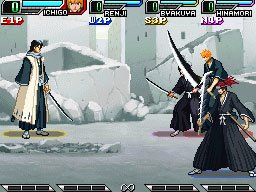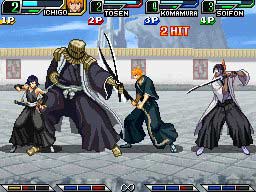 Ikki Tousen
Ikki Tousen isn't exactly the best manga ever drawn, not even close. In fact the English translation (
Battle Vixens) is pretty poor. The
anime is much better in that respect and is what I would recommend
getting into, at least until TOKYOPOP set things right by ordering a
complete retranslation. The plot deserves better than pretentious wise-crack rapper dialogue.
Yuji Shiozaki (the creator and manga writer) does seem to have very little imagination when it comes to female character design. They differ only in hair style and all tend to have massive boobs and exploding shirts... But he does know his female form.
One of the few characters that interest me is the Toushi known as Ryomou Shimei (呂蒙 子明) - the girl with a fetish for weird fashion and less than orthodox combat methods. If there was ever a figurine to own it would be Shimei's. Personally I have always found her to be one of the much better character design from the series (she is based on the
Three Kingdoms Lu Meng). Shimei specialises in grappling moves, which is particularly effective given her weapon of choice - the handcuffs.

Unfortunately 99% of all
Ikki Tousen related figures, including those of Ryomou Shimei, sucks - so I never had an opportunity to even consider getting one. Just because the manga is well known for its excessive ecchi content and fan service does not mean we want to have figurines with
boobs and other kinky materials displayed in the living room!

Wani Book's Ryomou Shimei
Blue Nurse version figure, sculptured by Yasuhiro Utajima, is by far one of two figurines based on the franchise that have caught my eyes (the other being the
cheerful Sonsaku Hakufu, but I didn't fancy the pose). And with good reasons too. No exploding clothes makes this a very conservative 1/7 scale PVC figure which we can proudly display on our Cargo manga bookcase without upsetting too many guests.

The build quality isn't perfect. The knee caps are weirdly boxy and the hair isn't as detailed as my
Jingai Makyo Ignis figurine. But then again Shimei only cost 4800 yen (this was a gift though). I do like the small details such as the cross on her chest (though the less than perfect paint almost ruined it). Utajima's sculpture of her facial expression pretty much captures her personality. The katana isn't as lovely as I would have preferred, though I did find the tsuka hilt to be pretty detailed.

Because of the pose, the crotch is well hidden - much to the relief of the household and guests. Speaking of poses, I love how Utajima decided to have Shimei kneeling in a battle ready position. It is far more ideal than most of the perverted poses offered on other
Ikki Tousen figurines (for example this
Ryofu Housen figure, which while accurately depicting Shiozaki's
Ikki Tousen volume three cover, isn't something you would want on your mantelpiece.). Those who find this disappointing should not fret. Because the skirt is removable you will be able to instantly peek at underwear at your leisure.

The nurse outfit wasn't what I would have preferred. Instead I would rather have her in her trademark French maid outfit, but even then a nurse costume does highlight her penchant for bondage wares. The only thing original are her boots, eye patch, hair colour, mole, the aforementioned cross and her demur look. I kinda wished they would at least include her hand-cuffs, at the very least. On the positive side the costume isn't battle damaged.

There are currently two versions of this figure - the blue version reviewed here, and a limited edition
black version coming out over the next few months. Personally I would recommend the blue version. The black uniform is pretty cool, but they also changed her hair to grey for it, which unacceptably deviates from the manga, though I do think that black would probably do better in hiding any imperfections.

Likes:
- Classic fighting pose
- Non exploding costume
- OK build quality (for the price)
Gripes:
- Lack of detail, especially in the hair
- Not in her French maid costume
- Poor paint quality (especially knee-caps)
This figure was obtained from
NeonMartian.com, a Swindon based site specialising in Japanese toys and figurines. Thanks Steve.
































